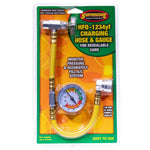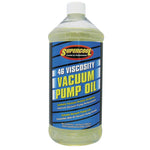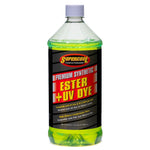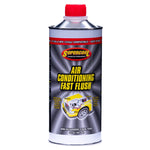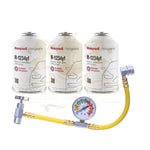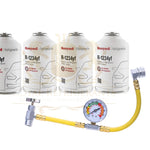You have no items in your shopping cart.
404A Refrigerant: A Comprehensive Guide to Its Uses, Benefits, and Alternatives
Introduction:
In the world of refrigeration, efficiency and environmental sustainability are key concerns. 404A refrigerant, commonly used in commercial refrigeration systems, offers a balance of performance and environmental friendliness. However, as the global focus shifts toward eco-friendly solutions, understanding the properties, benefits, and challenges of 404A is crucial. In this blog, we'll explore what 404A refrigerant is, its common applications, benefits, and some alternative options for those seeking greener choices.
What is 404A Refrigerant?
404A is a hydrofluorocarbon (HFC) refrigerant made up of a blend of three gases:
-
R-125 (pentafluoroethane)
-
R-143a (1,1,1-trifluoroethane)
-
R-134a (1,1,1,2-tetrafluoroethane)
This refrigerant is commonly used in refrigeration systems that require a low-temperature environment. It has a zero ozone depletion potential (ODP), meaning it doesn't contribute to ozone layer depletion, making it more environmentally friendly than older refrigerants like R-12.
While 404A was once a go-to solution for many refrigeration needs, its global warming potential (GWP) is high, leading to growing interest in alternative refrigerants with lower environmental impact.

Common Applications of 404A Refrigerant:
404A is commonly used in commercial and industrial refrigeration systems. Here are some of the most common applications:
Commercial Refrigerators & Freezers:
404A is widely used in large-scale commercial refrigerators and freezers, such as those found in supermarkets, warehouses, and food storage facilities.
Ice Machines:
For ice production, especially in large quantities, 404A ensures optimal performance in low-temperature conditions.
Transport Refrigeration:
404A is used in refrigerated trucks, trailers, and shipping containers for transporting perishable goods at controlled temperatures.
Cold Storage Facilities:
Cold storage warehouses rely on 404A refrigerant to maintain the required temperature levels for long-term food and product storage.
Benefits of 404A Refrigerant:
Ozone-Friendly:
One of the most significant advantages of R-404A is its zero ODP (Ozone Depletion Potential). Unlike older refrigerants like R-12, which could damage the ozone layer, 404A is considered safer for the environment.
Energy Efficiency:
404A refrigerant helps refrigeration systems achieve high levels of energy efficiency, making it suitable for commercial and industrial applications where high performance is essential.
Compatibility with Existing Systems:
404A is a drop-in replacement for older refrigerants like R-502, making it a convenient option for upgrading existing refrigeration systems without requiring major modifications.
Stable Performance Across Temperatures:
404A performs efficiently across a wide range of temperatures, making it ideal for applications that require consistent cooling, such as in freezers or refrigerated trucks.
Challenges with 404A Refrigerant:
High Global Warming Potential (GWP):
While R-404A is ozone-friendly, its high GWP (around 3922) has raised concerns about its contribution to global warming. The refrigerant’s ability to trap heat in the atmosphere has made it a target for phase-out in many regions due to climate change concerns.
Cost:
R-404A can be relatively expensive, particularly during periods of high demand or low supply. Businesses need to weigh the cost of using this refrigerant against its benefits, especially as alternatives emerge.
Regulations and Phasing Out:
Due to its high GWP, many countries, including those in the European Union and the U.S., are gradually phasing out R-404A in favor of more environmentally friendly options. The Kigali Amendment to the Montreal Protocol aims to reduce the use of high-GWP refrigerants, including R-404A.
Alternatives to 404A Refrigerant:
With growing environmental concerns, many businesses are exploring alternative refrigerants that offer similar performance but with lower GWP. Here are a few alternatives to consider:
R-448A (Proven):
This HFO-based refrigerant is a low-GWP alternative to R-404A, offering similar cooling performance while reducing the environmental impact. It is often used as a retrofit for systems originally designed for 404A.
R-449A (Opteon):
R-449A is another low-GWP refrigerant that is compatible with R-404A systems. It is becoming a popular choice for businesses seeking a more sustainable option.
CO2 (R-744):
Carbon dioxide is a natural refrigerant with a GWP of 1, making it one of the most environmentally friendly options available. It’s being increasingly used in large systems, especially in supermarkets and industrial refrigeration.
Conclusion:
R-404A refrigerant has been a staple in commercial and industrial refrigeration for years, offering reliable performance and energy efficiency. However, with the increasing focus on sustainability and global warming, its high GWP has led to a growing need for alternative refrigerants with lower environmental impact.
If you’re currently using R-404A in your refrigeration system, it’s essential to stay informed about regulatory changes and consider potential alternatives. As new refrigerants with lower GWP become more widely available, transitioning to these options can help reduce your business’s environmental footprint while maintaining performance and efficiency.
Ultimately, the right choice of refrigerant depends on your specific needs, budget, and environmental goals. Whether you choose to continue with R-404A or make the switch to a more eco-friendly alternative, being proactive about refrigerant management will help ensure that your system stays efficient and compliant with future regulations.
 English
English

